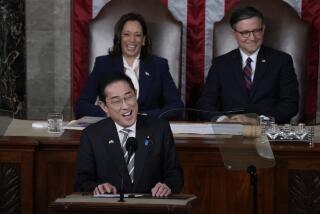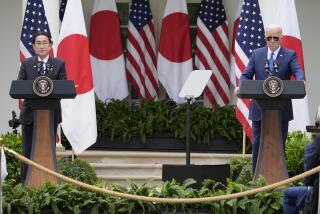A Symbolic First Meeting, With Hard Work to Come : Clinton- Hashimoto encounter paves way for April talks
- Share via
What better setting for the first meeting between President Clinton and Prime Minister Ryutaro Hashimoto than in sun-splashed Santa Monica on the edge of the Pacific Ocean? Many a friendship begins here, but few have been tested to the extent of U.S.-Japan relations of late. Beyond the symbolism of their get-acquainted session today, the two leaders will face sticky bilateral issues in April, when the president makes a state visit to Japan. Each faces considerable political pressures at home and abroad.
Their challenge is to hold to what’s best for both the United States and Japan, even when the goals for each nation seem to collide. There’s been progress on trade between the two countries but much more needs to be done. The security arrangement between the United States and Japan has been strained since the rape of a Japanese girl in Okinawa set off protests against the U.S. military presence. Three U.S. soldiers charged with rape await sentencing. These touchy issues overshadow other joint cooperative efforts by the two countries.
Having had to postpone the state visit to Tokyo last November because of the budget showdown with Congress, the president wants a smooth lead-up to the April visit. His administration has spent considerable effort, not always with great finesse or tact, to bring down the huge trade imbalance with Japan, and that has begun to pay off--Japan’s surplus with the United States posted its biggest decline in 16 years in January. While that is a huge and welcome improvement, American firms are still finding it difficult to crack some segments of the Japanese market. The semiconductor agreement with Japan will soon expire. Japan does not want to renew the pact but the United States does. A messy negotiation will play right into the hands of the protectionist sentiments of Republican presidential contender Patrick J. Buchanan.
Hashimoto is best known to American audiences as the Japanese trade minister who took a tough stand against U.S. demands during auto talks last year. Now he must project a more statesmanlike presence. He has pledged to lead a program of economic deregulation. But will he follow through? Concerned that Hashimoto may be backing off, the European Union has hinted it may join with the United States to discuss some trade issues with Japan.
The Japanese political scene has been fast changing since the Liberal Democratic Party lost power in 1993. Hashimoto is the fourth Japanese prime minister to meet with Clinton. But the bureaucrats who run Japan have remained and thus change has been slow in coming. Even Hashimoto, who supposedly epitomizes the new generation of young, plain-speaking politicians, is of the old LDP party and alliances.
But business and consumers in Japan are hungering for change. They are more vocal, especially on the U.S. military. A panel of Japanese and American officials are studying ways to better deploy American troops, now concentrated in Okinawa. Measures that take into account Japanese complaints about U.S. service personnel’s off-base behavior are crucial to maintaining the trust and support of Japan for the security agreement. These are the challenges for Clinton and Hashimoto.
More to Read
Get the L.A. Times Politics newsletter
Deeply reported insights into legislation, politics and policy from Sacramento, Washington and beyond. In your inbox twice per week.
You may occasionally receive promotional content from the Los Angeles Times.









